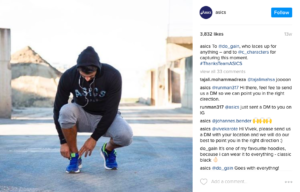I never feel comfortable running unless I have the Asics logo near me. Not just on my shoes, but also on my wicking-fabric shirt so that I know there will be no itches when I pass mile-8. Yes, Nike has the Prefontaine-Bowerman narrative that runner ‘historians’ enjoy, but I always picture Asics as the brand that pushes me to run a little further, stretch a bit more and make my shins feel painless.
It does not take much for this brand to convince me how great it is for runners. But it made me think of how can a runner-centric brand communicate its features for all athletes? Furthermore, how can it do so without potentially alienating its core audience? This made me think of Asics 2016 ‘Want it More’ campaign, where Asics and its agency, 180 Amsterdam, attempted to answer these questions:
http://https://www.youtube.com/watch?v=ETyxVQWKPzw
‘Want it More’ did not play it simple by generating awareness for the brand. Instead, it went deeper in addressing the obstacles one may have encountered while trying to achieve his/her fitness goals, whether it is just to simply remain healthy or to prepare for the next mud run. Cake, parties, gym selfies: these are a few of many challenges all athletes have experienced one way or another. It was a move on Asics’ part to create a connection with a relatable perception of what it means to be an athlete in a distracting world.
But as it expanded its targeted audience in 2016, its recent communications seem to have revert back in targeting runners while showing few references other athletes with the Asics brand. What could have halted Asics’ expansion after revealing the ‘Want it More’ campaign? Asics may have tailored ‘Want it More’ to earn preference over its competitors like Nike and Under Armour. But it seems to had fallen short in its conviction. Indeed, its communications had a mixture of implied and direct messaging that showed Asics to the brand that would help them ‘want it more’ in fitness. But one reason for the conviction not being as successful may stem from its targeted audience not being sold on setting aside their brand experience for a brand that they may still see as a ‘runners’ brand.
Convincing athletes who have a strong connection with Nike, for example, like I do with Asics is a hard thing to sell; but that does not mean its impossible. My view is that the ‘Want it More’ campaign was an over-reach in trying to target every type of athlete instead of targeting audiences who are considered ‘runner-adjacent’ (i.e., tennis players). Of course, Asics is not the only brand that attempted to expand its audience. Brands such as Nike, Skechers and New Balance had tried similar approaches, whether it is a form of celebrity endorsements or influencers. But one’s prior brand experience–the self-confidence of wearing Under Armour in a gym; the memory of wearing Asics GEL-KAYANO trainers in your first 20-mile run–stills play a factor on trusting another brand in wanting it more than before.
References:
Asics America. (2016, February 18). ASICS challenges all athletes to ‘WANT IT MORE’: integrated campaign launches with open letter calling on athletes everywhere to step up their training. PR Newswire. Retrieved from http://www.prnewswire.com/news-releases/asics-challenges-all-athletes-to-want-it-more-300222290.html.
Gianatasio, D. (2016, February 19). Asics gets down and dirty, and very sweaty, in 180’s ‘Want It More’ campaign. Adweek. Retrieved from http://www.adweek.com/creativity/asics-gets-down-and-dirty-and-very-sweaty-180s-want-it-more-campaign-169779/.



2 Responses to ‘Wanting it More’ May Not Be Enough